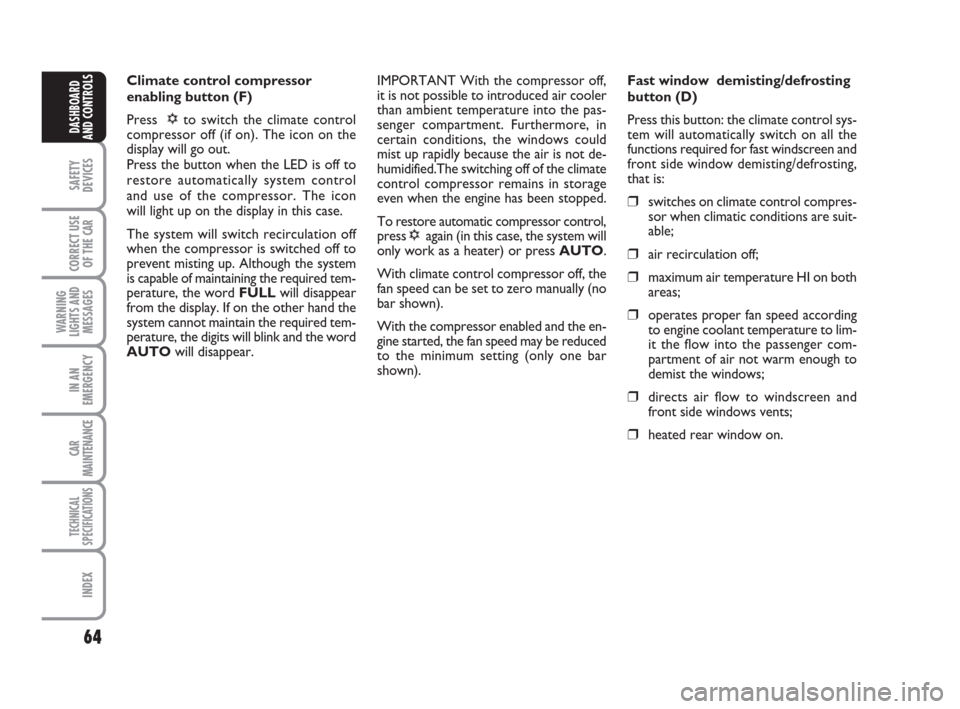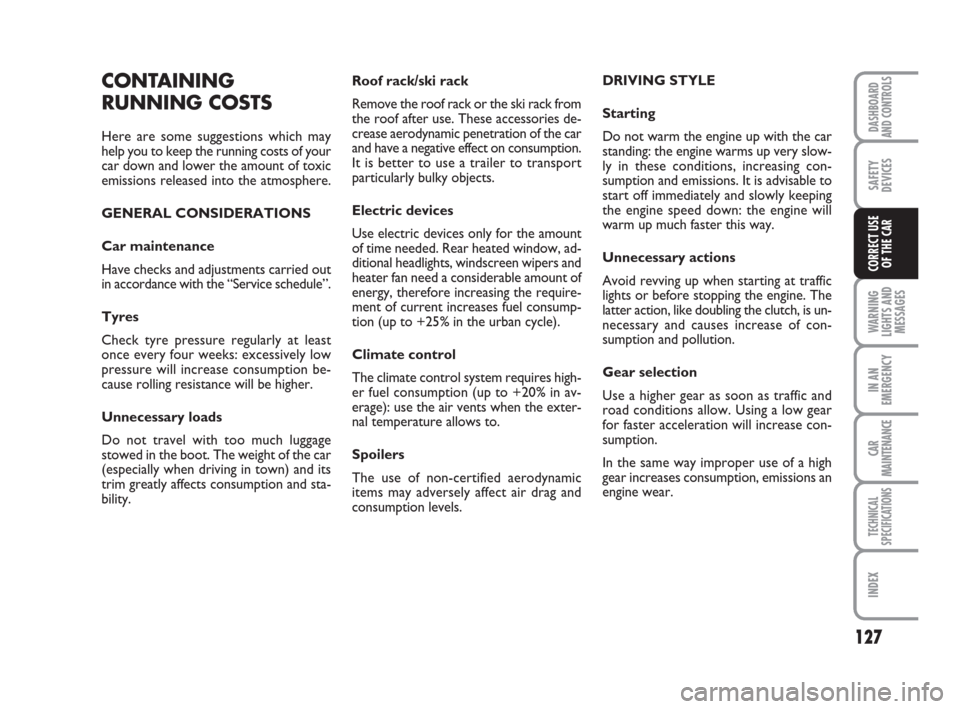heater FIAT LINEA 2008 1.G Owners Manual
[x] Cancel search | Manufacturer: FIAT, Model Year: 2008, Model line: LINEA, Model: FIAT LINEA 2008 1.GPages: 234, PDF Size: 3.41 MB
Page 65 of 234

64
SAFETY
DEVICES
CORRECT USE
OF THE
CAR
WARNING
LIGHTS AND
MESSAGES
IN AN
EMERGENCY
CAR
MAINTENANCE
TECHNICAL
SPECIFICATIONS
INDEX
DASHBOARD
AND CONTROLS
Climate control compressor
enabling button (F)
Press √to switch the climate control
compressor off (if on). The icon on the
display will go out.
Press the button when the LED is off to
restore automatically system control
and use of the compressor. The icon
will light up on the display in this case.
The system will switch recirculation off
when the compressor is switched off to
prevent misting up. Although the system
is capable of maintaining the required tem-
perature, the word FULLwill disappear
from the display. If on the other hand the
system cannot maintain the required tem-
perature, the digits will blink and the word
AUTOwill disappear.IMPORTANT With the compressor off,
it is not possible to introduced air cooler
than ambient temperature into the pas-
senger compartment. Furthermore, in
certain conditions, the windows could
mist up rapidly because the air is not de-
humidified.The switching off of the climate
control compressor remains in storage
even when the engine has been stopped.
To restore automatic compressor control,
press √again (in this case, the system will
only work as a heater) or press AUTO.
With climate control compressor off, the
fan speed can be set to zero manually (no
bar shown).
With the compressor enabled and the en-
gine started, the fan speed may be reduced
to the minimum setting (only one bar
shown).Fast window demisting/defrosting
button (D)
Press this button: the climate control sys-
tem will automatically switch on all the
functions required for fast windscreen and
front side window demisting/defrosting,
that is:
❒switches on climate control compres-
sor when climatic conditions are suit-
able;
❒air recirculation off;
❒maximum air temperature HI on both
areas;
❒operates proper fan speed according
to engine coolant temperature to lim-
it the flow into the passenger com-
partment of air not warm enough to
demist the windows;
❒directs air flow to windscreen and
front side windows vents;
❒heated rear window on.
044-090 LINEA 1ed GB 3-09-2008 17:29 Pagina 64
Page 128 of 234

127
WARNING
LIGHTS AND
MESSAGES
IN AN
EMERGENCY
CAR
MAINTENANCE
TECHNICAL
SPECIFICATIONS
INDEX
DASHBOARD
AND CONTROLS
SAFETY
DEVICES
CORRECT USE
OF THE CAR
Roof rack/ski rack
Remove the roof rack or the ski rack from
the roof after use. These accessories de-
crease aerodynamic penetration of the car
and have a negative effect on consumption.
It is better to use a trailer to transport
particularly bulky objects.
Electric devices
Use electric devices only for the amount
of time needed. Rear heated window, ad-
ditional headlights, windscreen wipers and
heater fan need a considerable amount of
energy, therefore increasing the require-
ment of current increases fuel consump-
tion (up to +25% in the urban cycle).
Climate control
The climate control system requires high-
er fuel consumption (up to +20% in av-
erage): use the air vents when the exter-
nal temperature allows to.
Spoilers
The use of non-certified aerodynamic
items may adversely affect air drag and
consumption levels.DRIVING STYLE
Starting
Do not warm the engine up with the car
standing: the engine warms up very slow-
ly in these conditions, increasing con-
sumption and emissions. It is advisable to
start off immediately and slowly keeping
the engine speed down: the engine will
warm up much faster this way.
Unnecessary actions
Avoid revving up when starting at traffic
lights or before stopping the engine. The
latter action, like doubling the clutch, is un-
necessary and causes increase of con-
sumption and pollution.
Gear selection
Use a higher gear as soon as traffic and
road conditions allow. Using a low gear
for faster acceleration will increase con-
sumption.
In the same way improper use of a high
gear increases consumption, emissions an
engine wear.CONTAINING
RUNNING COSTS
Here are some suggestions which may
help you to keep the running costs of your
car down and lower the amount of toxic
emissions released into the atmosphere.
GENERAL CONSIDERATIONS
Car maintenance
Have checks and adjustments carried out
in accordance with the “Service schedule”.
Tyres
Check tyre pressure regularly at least
once every four weeks: excessively low
pressure will increase consumption be-
cause rolling resistance will be higher.
Unnecessary loads
Do not travel with too much luggage
stowed in the boot. The weight of the car
(especially when driving in town) and its
trim greatly affects consumption and sta-
bility.
121-132 LINEA 1ed GB 3-09-2008 17:30 Pagina 127
Page 180 of 234

179
WARNING
LIGHTS AND
MESSAGES
TECHNICAL
SPECIFICATIONS
INDEX
DASHBOARD
AND CONTROLS
SAFETY
DEVICES
CORRECT USE
OF THE CAR
IN AN
EMERGENCY
CAR
MAINTENANCE
30 60 90 120 150 180
●●●●● ●
●●●●● ●
●●●●● ●
●●●●● ●
●●●●● ●
●● ●
●●●●● ●
●●●●● ●
●●
●●
●
●●●●● ●
●● ●
SERVICE SCHEDULE PETROL VERSIONS
Service coupons shall be performed every 30,000 km
Thousands of kilometres
Check tyre conditions/wear and adjust pressure if
required
Check light system operation (headlights, direction indicators,
hazard lights, boot lights, passenger compartment lights,
instrument panel warning lights, etc.)
Check windscreen wiper/washer operation
Check of conditions and wear of pads of front disk brakes
Check of conditions and wear of pads of rear disk brakes
(T-JET version)
Check rear drum brake linings and wear
Visually inspect conditions and integrity: bodywork,
underbody protection, pipes and hoses
(exhaust - fuel - brakes), rubber parts
(boots, sleeves, bushes, etc.)
Check cleanness of locks, bonnet and boot and lever
cleanness and lubrication
Check tension and adjust accessory drive belts
(1.4 with heater)
Visually inspect accessory drive belt conditions
Replace accessory drive belt/s
Check and adjust handbrake lever stroke, if required
Check and adjust tappet clearance, if required
177-200 LINEA 1ed GB 3-09-2008 17:31 Pagina 179
Page 223 of 234

222
WARNING
LIGHTS AND
MESSAGES
DASHBOARD
AND CONTROLS
SAFETY
DEVICES
CORRECT USE
OF THE
CAR
IN AN
EMERGENCY
CAR
MAINTENANCE
TECHNICAL
SPECIFICATIONS
INDEX
Boot ........................................................ 86
– extension........................................ 87
– opening/closing the tailgate ......... 86
– emergency opening....................... 83
Boot light............................................... 74
Brake assist .......................................... 92
Brakes
– fluid level ........................................ 188
– technical data ................................ 207
Bulb (replacement)
– general instructions ..................... 158
– types of bulbs ................................ 158
Capacities ............................................ 106
Car inactivity ....................................... 132
Car maintenance
– periodical checks........................... 183
– scheduled servicing ...................... 178
– service schedule ...................179-181
– use of the car under
heavy conditions................................ 183
Card box - CD box............................. 72
Carrying children safely ..................... 109
Ceiling lights.......................................... 72
– boot light ....................................... 66
– courtesy ......................................... 66– front ................................................ 64
– puddle/door .................................. 74
– rear ................................................. 65
Central console oddment
compartment..................................... 71
Chassis (marking) ............................... 203
Checking fluid....................................... 184
Child lock.............................................. 83
Child restraint systems
– “Universal Isofix” ......................... 114
– Passenger’s seat compliance ...... 115
Cigar lighter.......................................... 80
Clutch ................................................... 207
CO
2emissions...................................... 221
Code Card ........................................... 6
Consumption
– engine oil ........................................ 186
– fuel ................................................... 219
Controls................................................ 75
Correct use of the car ...................... 127
Cruise Control..................................... 70
Courtesy lights..................................... 74
– bulb replacement .......................... 174
– control button .............................. 74
Current outlet...................................... 73
ABS system.......................................... 92
Accessories purchased
by the owner .................................... 100
Additional heater................................. 56
Air bag
– front................................................. 115
– side .................................................. 118
Air cleaner............................................. 190
Adjustable Air vents ........................... 50
Alarm...................................................... 11
Armrest................................................. 79
Ashtray................................................... 80
ASR system........................................... 95
– activation/deactivation................. 95
At the filling station ............................ 101
Automatic climate
control system .................................. 59
Battery
– checking the charge ..................... 190
– jump starting ................................. 146
– recharging ...................................... 185
– replacing ......................................... 191
Bodywork
– maintenance .................................. 196
– version codes ............................... 204
Bonnet .................................................. 88
II I
N N
D D
E E
X X
222-232 LINEA 1ed GB 9-09-2008 14:25 Pagina 222